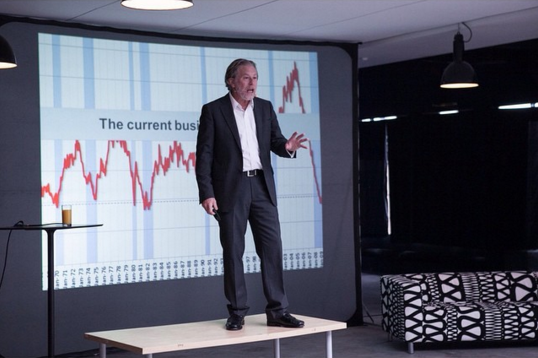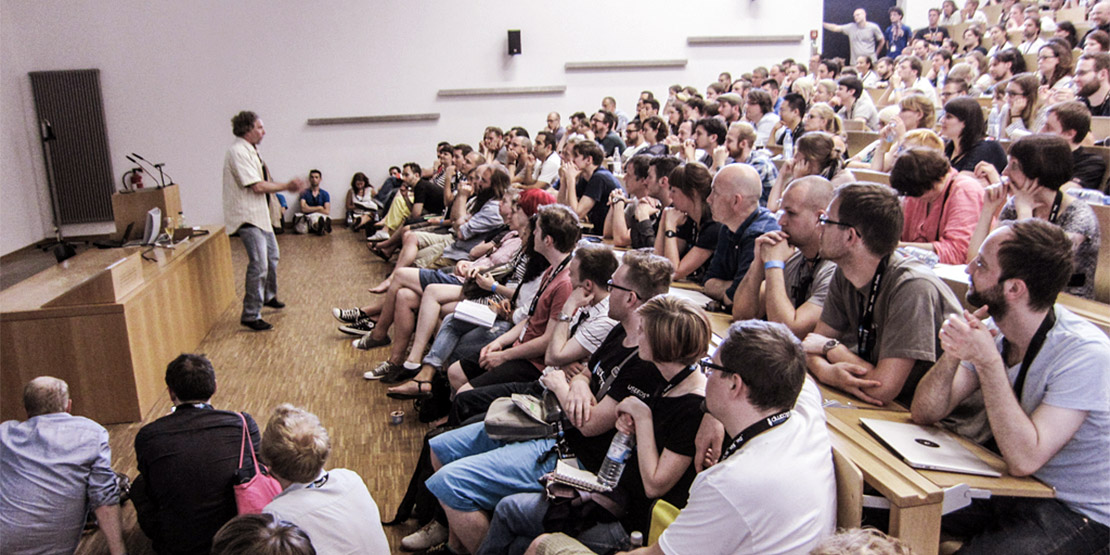Past, Present, Future – The Interview with Eric Reiss
12 November 2015, Małgorzata TraczykEric Reiss – one of the most interesting people in UX world. We asked him some questions about his past and success story. But also about the future of UX and UX innovation. Enjoy!
Małgorzata Traczyk: How did it happen that you became a UX professional?
Eric Reiss: I’ve always been concerned with User Experience. Remember, it’s only recently that people started calling it “UX”. Even as a very small child, I was always looking for ways to make my experiences better – from redesigning toys, to rearranging the furniture. You know the standard kid’s question, “Why”. Well, I was just as likely to ask “Why not…” and suggest an alternative. Later, my first jobs were in the theatre, which is about as user-experience-oriented an environment as you will ever find.
MT: FatDUX is a great UX consulting company. Could you give us a short story of your company? What do you think is a recipe for your success?
ER: When we founded FatDUX back in 2006, our concept was simple: build a strong brand, create a good process, and keep the tools simple. And this has helped us attract some of the best and brightest strategists and designers. And some very good clients, too. We’ve kept our offices very small and often rely on virtual teams. This lets us put together teams that are custom tailored to the needs of our clients. It keeps costs down and quality up. To be honest, I think the days of the big agencies are drawing to a close – and our model has now been copied by successful companies both in Europe and North America.
MT: What are the greatest advantages of working in UX? And have you had these moments, when you though “UX is a bullshit job”?
ER: There’s no BS about UX. But there is a lot of BS in the way it is practiced. Here at FatDUX, UX is a matter of doing three things: Coordinating the interactions we can control; reducing potential negative interactions; acknowledging interactions that are beyond our control. And these interactions can be between people, devices, and events. This is a really solid definition because it is actionable and measurable. The only times I get frustrated is when I see so-called “professionals” confuse and confound their clients with vague talk about UX.
I still hear a lot of “oh, we’ll sprinkle our magic UX pixie dust on your crappy product and make it wonderful.”
UX has already become a buzzword, which is very sad. I hate to see it devalued even more by agencies that are not really interested in UX and may not even understand it – they use UX as a springboard to sell their core activities – development, for example. For me, UX is the core activity that defines all the other stuff.
MT: You have taken part in many projects and UX implementations. It is known, that during such work we might succeed or not. Do you have one project or a history that you are the mostly proud of?
ER: I have many projects of which I am proud. But I also have NDAs with most of my clients, so I can’t say anything very specific. Also, a lot of what we do is hidden in the background, so it can be difficult to demonstrate.
However, I can tell you that a few years back, we had a tough web redesign project for the International Labour Organisation in Geneva. We did our research, developed a set of personas, and then locked everyone who had anything to say about the project – content providers, IT specialists, department chiefs, etc. – in a meeting room for three days. FatDUX provided a core team from three countries who coordinated the four main project teams – strategy, design, information architecture, development. And at the end of the three days, we had a set of success metrics, a revised sitemap, wireframes, a graphic design, and a development schedule. Best of all, we had sign-off from every decision maker.
Basically, because everyone who had input was right there in the room, there was no need for emails and extra meetings. It was just about as agile a process as you could want. And we essentially took a 3-5 month project and did it in just a matter of days – at a very competitive price, too.
Ultimately, though, the credit for the success of the project really goes to the ILO themselves. It is rare to work with a client with the vision and courage exhibited by the leaders in the Department of Communications who hired us. It was a very gutsy thing to do in such a highly political organization.

MT: UX people are often forced to work at the “best they can” level. So, sometimes they aren’t very proud of their work. Factors are different – financial, organizational, technical, political. As a long-time thought leader in the UX community, do you have some advice for them? What they should do in such situations? Can they affect the project, or maybe just get more flexible with their own ambitions?
ER: To answer the second part first, yes, they can affect the project in a positive way. They have to! If they don’t, their employer is going to wonder why they are on the payroll. Certainly there will be compromises that need to be made, but this is true of every project. If people aren’t flexible, they will run into problems – not just in a UX position, but in any position.
The first part of your question is the really critical one. Quite frankly, if an employer doesn’t know what you do or how you help create value for the business, there is going to be frustration on all sides. And even if a company does understand the value aspect of the work, but undervalues the employee, this person is going to start looking for a new job.
For this situation to change, three things have to happen.
First, the value of UX has to be made tangible and measureable. Right now, most companies don’t even have a clear baseline established, so if the UX process has improved anything, it may not be visible or verifiable. This is why the FatDUX definition of UX that I outlined earlier works so well – it’s actionable, measurable, and most important of all, understandable.
Second, companies must understand that UX is not just something that happens on a screen – the offline UX is just as important, often even more so. For example, just think how people rave about Apple’s packaging – that’s part of a UX strategy that fits directly into Apple’s business strategy. But when it comes to the digital side of things, well, Apple simply can’t design software. Just look at iTunes – it’s one of the most dysfunctional products around. People use it because they have to, not because they want to. By the way, I don’t think one in a hundred companies knows what a UX strategy is or does, even though they may claim to have one already.
Third, with very few exceptions, companies do not know where to place UX within the corporate structure. There is no “UX department.” And with no one in charge, that means no one is accountable. And if no one is accountable, then who cares? UX becomes just another buzzword.
So, we have a lot of work to do in educating our employers and clients.
MT: You recently talked about diversification of job positions concerning website designs. During UX CampEurope 2015 in Berlin you presented the slide about the webmasters positions back in 1995 and all kinds of jobs in 2015 – UX designers, UI designers, UX strategists, etc. How do you find future structure of our jobs – will it continue to expand, or will we minimize the number of UX jobs positions – trying to get more coherent? What do you think about our responsibilities in future? Who will be the UXer in 2020?
Again, this comes back to ownership of UX. For large companies, I’m sure the teams will remain large. For smaller companies, they will hire in freelancers as needed for very specific projects – it’s like hiring a car trailer once a year to haul some stuff to the dump. You don’t need to have the trailer parked in your driveway all year round. I think everyone is going to become a little more pragmatic as the years go by when it comes to UX hires. And companies are simply not going to put up with the kind of title proliferation that we saw in digital agencies back in 1998.
As to the specific titles, personally, I don’t care what these titles are or how many people are on the official “UX Team.” What I am interested in, is that everyone throughout the entire organization understands the value of their own work vis-á-vis the total UX picture. In many ways, this is the story companies back in the 70s and 80s had to teach their employees with regard to service and product quality. Now the turn has come to UX. There is no “UX Team of One”!

MT: In the last few years we came to a point where it’s hard to design something ‘innovative’. Today, we have standards for all kinds of systems and functionalities. Even so, some companies are trying to get to the next level of User Experience – building system intelligence, working with big data, etc. What do you think will become the great UX innovation in the next few years? What kind of innovation do you think will be brought to User Experience in 2020?
ER: Let me preface my answer by explaining my view of innovation. It is a planned process – it doesn’t happen by accident. And it has to solve a problem. If it doesn’t, it will create a problem. This is why locking a bunch of creative thinkers in a room and telling them, “Come up with a cool idea,” doesn’t work. Innovation is not the same as invention.
So, where are we now in terms of UX? Well, we’re just coming out of a long economic depression – that’s what it was, no matter what our politicians tell us. We have viable best practices and we continued to learn, despite the economic crisis. In other words, we’re not making the same silly mistakes we made a decade ago.
To some extent, I think the next five years are going to be about consolidating our industry – educating clients, proving our value. Many innovations will be associated with maintaining current products and services – and any innovations will be incremental, not disruptive.
There are also serious issues that the entire community will be looking at – first and foremost the matter of privacy. Although privacy is a right guaranteed by the EU constitution, privacy is not a right in the U.S. constitution. Unfortunately, U.S. companies, like Facebook, Google, LinkedIn, Twitter, etc, control social media and tend to take a very “broad view” when it comes to privacy (I’m being as diplomatic as I can possibly be in my choice of words).
So, over the next five years, we are going to have to take a very close look at privacy and the laughable “cookie policy” that has been created by the EU in a feeble attempt to protect its citizens. And we will also be revisiting the permissions an app can receive when you download something to your mobile phone. Today, people have no idea that they have probably given dozens of apps permission to turn on their microphone and listen to their conversations, or turn on the camera to see what’s going on. We live in scarier times than most people think.
In terms of broader innovations, right now, social media represents a high percentage of internet traffic. But there are problems. For example, yesterday, I had messaging conversations on Skype, LinkedIn, Xing, Twitter, Facebook, SMS, and email. And when conversations move from one app to the next, it is difficult to keep track of what was said – and if you are conducting business, what agreements were reached.
I think we need to start looking at social media as blocks of Lego: some stuff is good for microblogging, other stuff for posting photos, etc. These days, every channel seems to be striving to supplement their core value proposition with irrelevant features. For example, LinkedIn is no longer a select network of trusted business people, it is a blogging tool for business professionals who don’t want to set up their own blog. I think we will soon see a day when we will not use Facebook, but will create our own customized app that will take user interfaces and functionality from a variety of sources and click them together in a way that really suits our personal needs. For example, we can combine Facebook with Twitter with Instagram with Skype with whatever – to build something we like to use. And if we choose Skype for messaging and voice, for example, messages from other sources (FB, Twitter, LinkedIn) will automatically channel to our preferred “block of Lego”.
Sorry for the long ramble. But there is much to think about these days. I hope you’ll ask me again in five years!
Eric Reiss has held a wide range of eclectic jobs: piano player (in a house of ill-repute), senior copywriter (in an ad-house of ill-repute), player-piano repairman, adventure-game creator, and stage director. His experiences have served him admirably as an information architect, although he can’t explain exactly how.
In more mundane lives, Eric has been a two-term president of the Information Architecture Institute and Professor of Usability and Design at IE Business School in Madrid, Spain.
Today, Eric is CEO of the FatDUX Group in Copenhagen, Denmark, a leading UX company with offices and associates in over a dozen cities worldwide. He also has several books to his credit.
If you want to contact with Eric, catch him on Twitter – @elreiss.
Take a look also at the FatDUX website.


